Icewine is a unique sweet wine made from grapes that have been left to freeze naturally on the vine. The taste is like liquid gold.
Canada is a global leader for Icewine production, and 95% of that Icewine is made in Niagara, Ontario. We took a road trip to witness the frigid harvest.
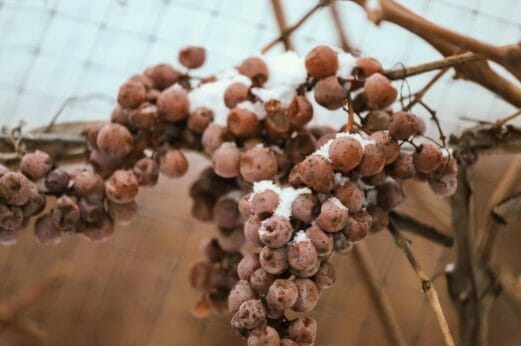
Photo by Katie Desharnais
Icewine got its start in Canada in the early 1980s. With close to ideal climate conditions (warm summers to ripen grapes coupled with not too cold winters), Ontario is where it’s at for creating Icewine. The appellations of the Niagara Peninsula, Prince Edward County and Lake Erie North Shore boast mostly limestone-based shale, and clay loam. Again, pretty ideal conditions. While about 60 local wineries produce it, grapes for Icewine comprise only about 15% of Ontario’s annual crop.
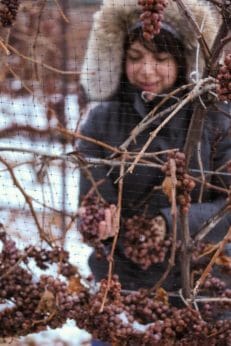
Photo by Katie Desharnais
In preparation for Icewine season, the grape vines are netted in the autumn when the grapes are ripening to protect them from being snatched by birds. In November, the grapes must be registered with VQA (Vintners Quality Alliance) inspectors, whereupon the grape variety, acreage and estimated tonnage are verified. The grapes are then left on the vine until a sustained temperature of minus 8 degrees Celsius or lower is reached. Depending on the season, this could happen anytime from December to February. (Here, the writer braves the cold for about 20 minutes of fake harvesting for a photo op.)
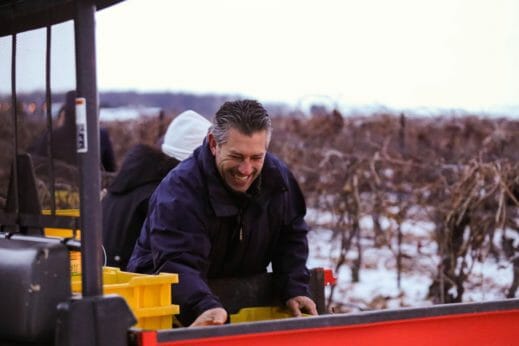
Photo by Katie Desharnais
During Icewine season, wineries and grape growers like Trevor Falk of Falk Vineyards, keep a careful watch on the weather forecast, looking for a stretch of temperatures between -10 and -12 °C. This specific range will produce juice in the range of 35 to 39 ° Brix (roughly equivalent to the percent sugar in the juice). Typically, a period of at least 6 hours is needed to harvest and press the grapes – and it’s usually an overnight job. Still, Trevor keeps on smiling.
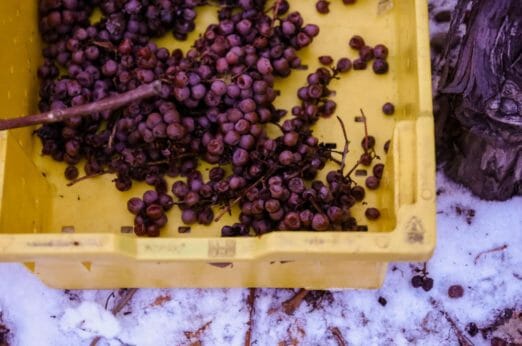
Photo by Katie Desharnais
During the time between the end of the growing season and harvest, the grapes dehydrate and the juices are concentrated and develop the characteristic complexity of Icewine. The typical varietals used for Icewine in Ontario are Vidal, Riesling and Cabernet Franc. They thrive here.
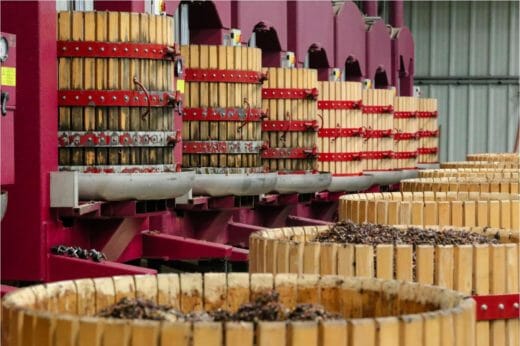
Photo by Katie Desharnais
Once the grapes are harvested, they are pressed in small hydraulic presses under higher pressure than is normal for grapes harvested during the regular season. That’s because these grapes are frozen; most of their mass is water and is left behind as ice in the press. Only a small amount of concentrated juice is extracted.
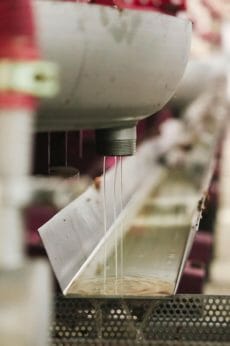
Photo by Katie Desharnais
Pressed while still frozen, the grapes yield a sweet concentrated juice that is incredibly flavourful; almost like a nectar. Look at how thick that looks.

Photo by Katie Desharnais
Imagine if grape juice tasted like cotton candy, sunshine and rainbow ponies all wrapped into one delicious gulp? That’s what this freshly pressed Icewine juice tastes like. “Enjoy every drop,” says Falk Vineyards patriarch, Bill Falk. “That glass is worth about $8 of Icewine,” he winks.
Upon seeing the operation first hand, I look forward to educating myself further by receiving your news letter.
Je cherche du travaille au canada